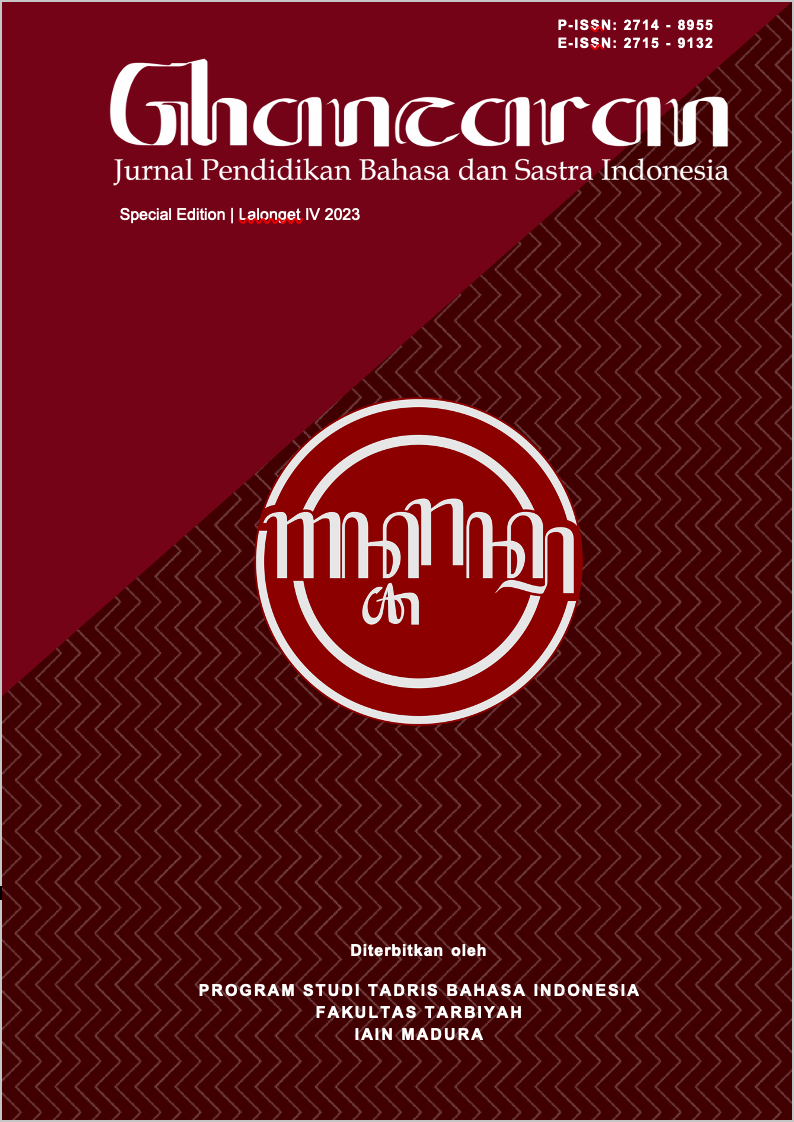Resistensi dalam E-Cerpen Karya Muna Masyari dan Relevansinya terhadap Pembelajaran Bahasa dan Sastra Indonesia
 Abstract views: 346
,
Abstract views: 346
,
 PDF downloads: 262
PDF downloads: 262
Abstract
One type of literary work that is accepted and quite popular in society is the short story. The increasingly rapid development of technology means that short stories, which were originally only in print or book form, are now available electronically or digitally (E-Short Stories). In short stories, sometimes there is criticism that the author wants to convey against the background of existing problems. Muna Masyari, as one of the Madurese authors, presents criticism in the short stories she writes as a form of resistance to the problems that occur in the Madurese community's life system, especially in the cultural system. The aim of this research is to describe open and closed resistance in Muna Masyari's E-Story and its relevance to learning Indonesian language and literature. The method used in this research is a qualitative descriptive method. Data in the form of words, sentences and paragraphs containing open and closed forms of resistance in Muna Masyari's e-short stories and their relevance to learning Indonesian language and literature. Meanwhile, the data source for this research is E-Story by Muna Masyari. The data collection technique in this research uses document study. Then, the data analysis technique uses Miles & Huberman's interactive analysis technique. The research results show that there are 2 forms of resistance, namely open and closed resistance in Muna Masyari's e-short stories, as well as works created by authors that are relevant if used as learning content for Indonesian language and literature.
Downloads
References
Aswan. A., Harsiati, T., & Widyartono, D. (2023). Metode Field Trip Berbasis Virtual Reality pada Pembelajaran Menulis Puisi: Sebuah Desain Pembelajaran Digital di Era Kurikulum Merdeka. JSS: Jurnal of Smart System, 3(1), 10-24.
Marsuki., & Rokhyanto. (2015). Sikap Masyarakat Madura terhadap Tradisi Carok. El Harakah: Jurnal Budaya Islam, 17(1), 71-83.
Moleong, L. J. (2011). Metodologi Penelitian Kualitatif. Bandung: Remaja Rosdakarya.
Mustikawati, A. (2019). Resistansi terhadap Penyimpangan Kekuasaan dalam Tiga Cerpen Kalimantan Timur. LOA: Jurnal Ketatabahasaan dan Kesusastraan, 14(2), 139-150.
Nugroho, B. A., & Suhendi, I. D. (2022). Stereotip dan Resistensi Perempuan dalam Cerpen Payudara Nai-Nai Karya Djenar Maesa Ayu. Jsi: Jurnal Sastra Indonesia, 11(1), 78-84.
Nurgiyantoro, B. (2013). Teori Pengkajian Fiksi. Yogyakarta: Gadjah Mada University Press.
Rahman, S. (2022). Representasi Pariwisata Budaya Madura dalam Puisi Sastrawan Madura dan Relevansinya sebagai Materi Pembelajaran Sastra di Era Merdeka Belajar. Ghâncaran: Jurnal Pendidikan Bahasa dan Sastra Indonesia, Special Edition: Lalonget III, 169-180.
Scott, J. C. (2000). Senjatanya Orang-Orang yang Kalah. Jakarta: Yayasan Obor Indonesia.
Simanjuntak, N. M. (2019). Representasi Tokoh Ayah dalam Cerpen Digital “Lakon Hidup” Edisi September 2018: Kajian Aktansial. Fonema: Jurnal Edukasi Bahasa dan Sastra Indonesia, 2(1), 59-66.
Suyitno, I. (2018). Pemanfaatan Potensi Lingkungan dan Budaya Lokal dalam Pendidikan bagi Generasi Mileneal. Seminar Nasional “Eksplorasi Bahasa, Sastra, dan Budaya Jawa Timuran sebagai Upaya Penguatan Pendidikan Berbasis Ekologi”.
Zulfikar, M. F., Saryono, D., & Syahri, M. (2021). Bentuk Resistensi Terbuka Kaum Tani dan Buruh dalam Cerpen-Cerpen Sastrawan Lekra di Koran Harian Rakjat. Jurnal Pendidikan: Teori, Penelitian, dan Pengembangan Universitas Negeri Malang, 6(9), 1384-1399.
Copyright (c) 2023 GHANCARAN: Jurnal Pendidikan Bahasa dan Sastra Indonesia

This work is licensed under a Creative Commons Attribution-ShareAlike 4.0 International License.
Ghancaran: Jurnal Pendidikan Bahasa dan Sastra Indonesia uses an Open Access Policy under the Creative Commons Attribution-ShareAlike 4.0 International License. Authors publishing in this journal agree to the following terms:
- Ghancaran Journal holds the copyright and grants the journal rights for first publication with the work simultaneously licensed under a

The work is distributed under Creative Commons Attribution-ShareAlike 4.0 International License which allows others to share, copy, and redistribute the material in any media or format and adapt, remix, change, and develop the material even for commercial purposes, as long as it is stated credit and license derivative works under similar terms. - Authors may make additional contractual arrangements for non-exclusive distribution of the journal's published work version.
- Authors are permitted to post their work online (e.g., in institutional repositories or on their websites) before and during submission, as doing so may lead to productive exchange.



















